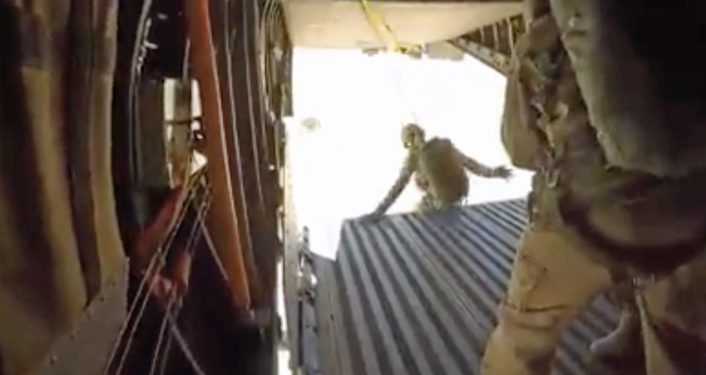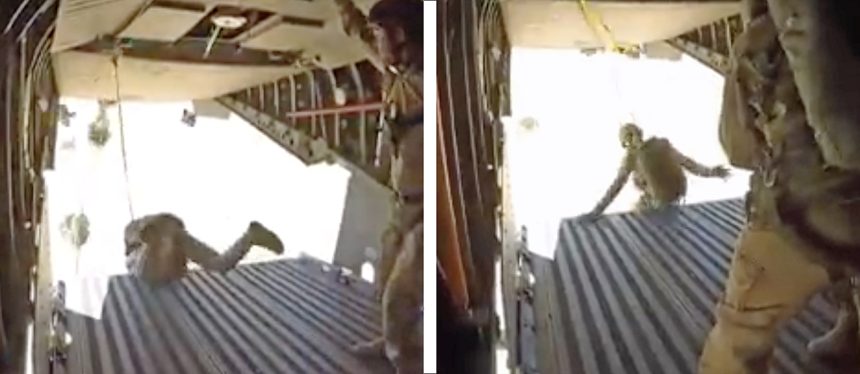Jumpers Execute Dangerous Exits, Ramp Strikes and Falls in One Jump Exercise.
Military static line parachuting is safe when practiced correctly, but minor mistakes can quickly turn a jump into a disaster. Take a look at these.
This video appeared on social media early this week from the Flintlock 2019 military exercise in the Sahel region of Africa. Whoever the unit is in the video- and no one is giving them credit (or blame…), they demonstrate about every aircraft exit mistake a static line parachutist can make short of actually forgetting to hook up their static line.
The video has disappeared from social media, but we managed to make a video of the video before it disappeared.
The first man looks like he is trying to do a side-door exit from an aircraft, when he’s actually using the tailgate. It’s weird, because tailgating an aircraft- jumping from the rear cargo ramp, is easier than exiting the side door of an aircraft. U.S. paratroopers look forward to the rare opportunity to do a “Hollywood tailgate party”, a daytime static line jump from a rear cargo ramp without carrying heavy combat gear. It’s the safest, easiest jump a paratrooper can make. The first troop makes a safe exit, but his parachute deployment probably had some twisted parachute risers.
The third guy should be commended for his motivation, if not his style. It looks like he is doing a freefall exit, not a static line exit. It likely went OK for him, but the opening shock probably spun him around some, making for an uncomfortable parachute deployment.
The third man out executes a pretty nice exit; feet and knees (sort of) together, relatively tight body position, hands protecting his reserve parachute. The black hat instructors at the U.S. Army Airborne School at Ft. Benning might give this exit a “Go”.
Things really go south for the fourth guy, who face plants on the exit ramp. He may have been hesitant to exit, he may have tripped on the non-skid surface of the exit ramp, hard to say, but he makes an incredible mess of the exit and belly-flops out the rear exit ramp. This is extremely dangerous because falling on your reserve parachute, worn in front by these jumpers, could accidentally deploy it. It may get tangled in the jumper’s main parachute and, at low jump altitudes of around 600-800 feet and sometimes even less, could cause a catastrophic malfunction with way too fast of a descent rate and no way to untangle the two chutes before impact. Expect broken bones at best.
The rest of the jumpers seem justifiably freaked out by this. But the fifth man sucks it up and makes a passable, if messy, exit. His feet are too far apart. Static line parachute jumpers must “maintain a tight body position and count” to insure the parachute does not accidentally deploy between their legs. I don’t have to explain why having the static line become high speed dental-floss deal between your legs would be bad.
Jumper number six just isn’t sure about this whole “Airborne!” thing. He decides to sit down on the exit ramp for a minute and contemplate his participation in the elite parachute infantry. Someone on the aircraft, presumably the jumpmaster, motivates him by shouting “GO!”. After his moment of quiet reflection on the future of his military career, he apparently decides that being an elite airborne trooper is worth a bit of a risk and tentatively tumbles off the ramp. He may have also calculated that leaving the aircraft from the seated position got him about two feet closer to the ground upon exit, thereby presumably making the jump safer.
Jumpers seven and eight both execute fairly decent exits, at least relative to the other jumpers, but that’s a pretty low bar.
Jumper nine defies description. He apparently deduces that using his butt as a kind of braking device upon exit may make his jump somehow safer or easier. Whatever the reason he smacked against the exit ramp on exit, that had to hurt. He also kind of flaps his arms in a bird-like motion. Maybe he doesn’t trust his ‘chute.

That was it for this stick of jumpers. It would seem as though these guys need to head back to the jump ramp simulator and practice some exits if they are going to continue their Airborne careers. Whatever the case may be, nearly every exit on this jump demonstrates what can go wrong when a static line tailgate parachute jump is executed poorly. For that reason, we owe these guys for 32 seconds of video that is destined to go down in Airborne history as a documentary on how not to leave an aircraft.
The Author of this article was a paratrooper in the U.S. Army.









